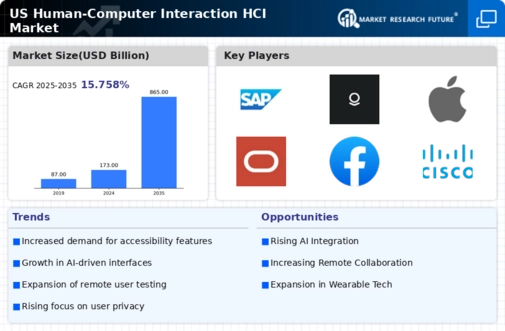Rise of Voice-Activated Interfaces
The human computer-interaction-hci market is witnessing a significant rise in voice-activated interfaces, which are becoming increasingly prevalent in consumer electronics and smart home devices. As of November 2025, it is estimated that over 50% of households in the US utilize voice-activated technology, indicating a shift towards hands-free interaction. This trend is largely driven by advancements in natural language processing and machine learning, which enhance the accuracy and efficiency of voice recognition systems. The market for voice recognition technology is projected to exceed $20 billion by 2026, suggesting a robust growth trajectory. This shift towards voice interfaces not only improves accessibility for users with disabilities but also caters to the growing demand for convenience in everyday tasks. As such, the proliferation of voice-activated interfaces is likely to play a pivotal role in shaping the future of the human computer-interaction-hci market.
Expansion of Augmented Reality Applications
The human computer-interaction-hci market is experiencing a transformative phase with the expansion of augmented reality (AR) applications across various industries. As of November 2025, the AR market is projected to reach $50 billion in the US, driven by its applications in education, retail, and training. This technology enhances user interaction by overlaying digital information onto the physical world, creating immersive experiences that engage users in novel ways. The integration of AR into everyday applications is likely to redefine how users interact with technology, making it more intuitive and engaging. Furthermore, as hardware becomes more accessible and affordable, the adoption of AR is expected to accelerate, potentially leading to a paradigm shift in the human computer-interaction-hci market.
Advancements in Gesture Recognition Technology
The human computer-interaction-hci market is experiencing a notable surge due to advancements in gesture recognition technology. This technology allows users to interact with devices through natural movements, enhancing user experience and engagement. As of 2025, the market for gesture recognition is projected to reach approximately $10 billion in the US, reflecting a compound annual growth rate (CAGR) of around 25% over the next five years. This growth is driven by the increasing demand for touchless interfaces in various sectors, including gaming, healthcare, and automotive. Companies are investing heavily in research and development to improve the accuracy and responsiveness of gesture recognition systems, which could lead to more intuitive and immersive user experiences. Consequently, the integration of this technology is likely to redefine interaction paradigms within the human computer-interaction-hci market.
Growing Importance of Data Privacy and Security
The human computer-interaction-hci market is increasingly shaped by the growing importance of data privacy and security concerns among users. As technology becomes more integrated into daily life, users are becoming more aware of the risks associated with data breaches and unauthorized access. Recent surveys indicate that over 70% of consumers prioritize data security when choosing technology products, which is influencing design and development strategies. Companies are now focusing on creating interfaces that not only enhance user experience but also prioritize security features, such as biometric authentication and encrypted communications. This shift is likely to foster trust and loyalty among users, ultimately impacting the competitive landscape of the human computer-interaction-hci market.
Increased Demand for Personalized User Interfaces
The human computer-interaction-hci market is increasingly influenced by the demand for personalized user interfaces that cater to individual preferences and behaviors. As technology evolves, users expect interfaces that adapt to their unique needs, enhancing overall satisfaction and engagement. Recent studies indicate that personalized experiences can lead to a 30% increase in user retention rates, highlighting the importance of customization in design. Companies are leveraging data analytics and machine learning to create adaptive interfaces that respond to user interactions in real-time. This trend is particularly evident in mobile applications and e-commerce platforms, where tailored experiences can significantly impact conversion rates. As the market continues to evolve, the emphasis on personalization is likely to drive innovation and competition within the human computer-interaction-hci market.

















Leave a Comment